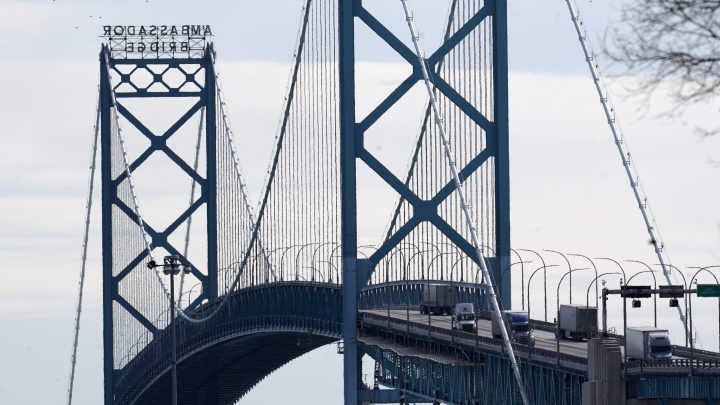
Toronto police Det. Scott Ferguson follows every Ontario law enforcement agency on Twitter and others across the country.
If there is a firearm seizure by police in Windsor, Hamilton or even Calgary that Ferguson notices, he’ll put in a call.
“Everybody likes to brag when they get something,” said Ferguson, who heads Ontario’s firearms analysis and tracing enforcement (FATE) program.
“If I find out an agency isn’t tracing, even if it’s outside of Ontario, I shame them,” he said. “I will call them up and say, ‘Why aren’t you tracing your guns?”
Amid a rise in shootings in major Canadian cities such as Toronto and Calgary, some experts who study firearms trafficking say the country needs to drastically increase the number of firearms traced through the U.S. Bureau of Alcohol, Tobacco, Firearms and Explosives (ATF).
“Without the tracing being done, there’s no way to identify the retail purchaser in the United States, and therefore, there’s no way to stop them from smuggling or trafficking firearms in the future,” said Chris Taylor, an ATF agent and the bureau’s attaché for Canada based out of Ottawa.
He works closely with Canadian police agencies across the country to tackle gun smuggling at the border.
“We need to know who’s doing it to be able to stop them,” he said.
“Without that tracing, there’s no way to identify these people or organizations.”
The ATF conducted close to 500,000 gun traces at the request of law enforcement officials in 2020, but only a few thousand are ever requested by police agencies north of the border.
The purpose of firearms tracing is to create a chain of custody, from the manufacturer to the licensed dealer to the purchaser.
If a gun is found at a crime scene, in Edmonton or Toronto, for example, its serial number can be submitted to Ontario’s FATE program or to the RCMP’s Canadian National Firearms Tracing Centre, which then sends a request through the ATF’s “eTrace” program.
The average trace time is about four to seven business days, according to the ATF. In some cases, if the serial number is obliterated, forensic experts can use methods to restore it.
What police receive back is a trace document outlining crucial details about the life of the gun and who bought it.
It’s not perfect, but it can help spark investigations, both in Canada and the U.S, into bulk or straw purchasing – where someone is actually buying a gun on behalf of another person. Data from the Giffords Foundation, a gun control advocacy group, indicated there are more than 30,000 straw purchase a year in the U.S.

Ontario’s little-known FATE program is part of the Criminal Intelligence Service of Ontario and works with agents from the Canada Border Services Agency (CBSA) and the ATF to source crime guns seized across the province.
“This is a commodity that kills,” Ferguson said. “It’s good intelligence that comes from firearms tracing that will lead to (a buyer’s) identity, a method of travel, a method of crossing.”
Secreted in “trap” compartments in cars, stored in shipping containers, or even in gas tanks, it’s unknown how many guns are smuggled across the border every year. Last year, CBSA seized over 1,100 guns – a 55 per cent increase from 2019.
Toronto police have said around 85 per cent of its crime guns are sourced from the U.S., but Canada still has no national data that tracks the sources of its illegal guns.
- 2 teens charged with murder in case of 16-year-old killed outside Halifax mall
- Green Party deputy leader given jail sentence for Fairy Creek old growth protests
- Cars torched, explosions heard in suspected arson in Montreal neighbourhood
- Gas station clerk stabbed several times during violent attack at Ultramar in Montreal
With the ease of purchasing firearms in the U.S., the sheer volume and a massive border, illegal guns from the States will continue to be an ongoing problem for Canadian cities.
And with hundreds of thousands of border crossings a day in Ontario, Ferguson and others who’ve studied the issue say better intelligence can help stem the flow of guns by targeting specific vehicles.
In 2018, several agencies in both Canada and the U.S. were able to disrupt a smuggling ring, resulting in 25 handguns being uncovered inside the gas tank of a rental Nissan Rogue that was driven by a Toronto woman across the Peace Bridge into Fort Erie. Each gun was sealed in plastic.
Ferguson said a separate firearm seizure and successful tracing efforts led to the multi-agency investigation into handgun purchases in Florida and Georgia.

The guns were purchased for between $300 and $500 and then smuggled across the border, where they could be sold in Ontario for between $2,000 and $5,000, police said at the time.
According to the RCMP’s 2019 firearms report, Canada’s police services seized some 26,351 guns by law enforcement across Canada in 2019, but just 1,768 guns were traced. In 2020, that number of firearms traced rose slightly to 2,143, according to the RCMP.
The RCMP’s numbers include firearms seized, turned in or found by police. There is no national data specifically on guns used in crimes and where they come from.
ATF Agent Taylor said last year there were roughly 31,000 guns seized by law enforcement, with around 21,000 guns being crime guns.
Taylor and other experts want to see Canada trace “100 per cent” of crime guns seized.
“We’re not near that yet, but we’re working to build capacity,” he said.
The RCMP did not respond to questions about whether it was working to provide better public information on where Canada’s crime guns are coming from, and how many are truly used in the commission of a crime.
B.C., Alberta, Quebec and Ontario account for the vast majority of Canada’s crime guns, according to Taylor. In all four provinces, it is not mandatory under the provincial police act to trace a gun used in a crime.
“The ministry continues to strongly encourage police services to submit this important information for analysis,” said a spokesperson for Ontario’s solicitor general.
In response to the rising gun violence in Canada, the federal government announced in March $312 million in funding to help curb shootings, with a significant amount of money going towards border enforcement.

A spokesperson for Public Safety Canada said the funding will increase the RCMP’s capacity to trace firearms and build a national system that allows for the flagging of bulk purchasing and straw purchasing.
The federal government has also announced the $250 million to help municipalities and Indigenous communities prevent “gun and gang violence” and help in banning more than 1,500 models of assault-style firearms.
“To address the conditions that contribute to a young person falling in with crime, the program will provide funds to eligible municipalities and Indigenous communities, who will support local organizations that focus on children, youth, and young adults who are involved in or at risk of joining gangs,” said a spokesperson with Public Safety Canada.
While the assault-style firearms ban or proposals of banning handguns have received widespread attention and press coverage, Taylor and other experts would instead argue that firearms tracing would be more effective.
“It will increase the awareness of the source of these crime guns being recovered across Canada,” he said. “It allows the ATF and partner agencies like the RCMP and municipal departments to better attack that problem.”





Comments